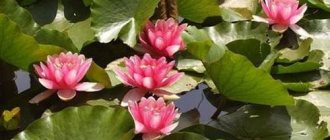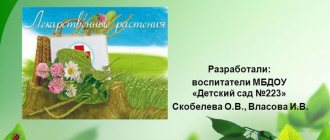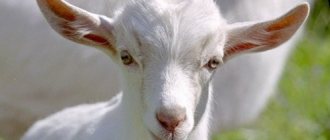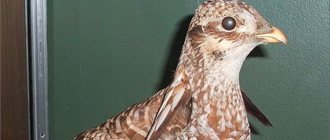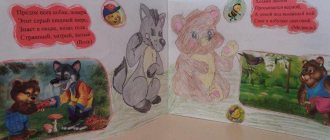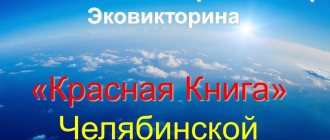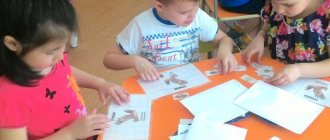ECOLOGICAL PROJECT “Red Book”
ECOLOGICAL PROJECT
“Red Book”
Educational project in the preparatory group
(creating a book from drawings by children, teachers, parents of rare and endangered species of plants, animals and birds).
Relevance
Can we live without nature, without birds, trees, butterflies and dragonflies, forests and meadows? The larger our cities become, the higher the houses, the more often we want to go further out of the city to our real common home - into nature. Man and nature... Philosophers, poets, artists of all times and peoples paid tribute to this eternal and always relevant topic. But this problem is especially acute these days, when the threat of an environmental crisis, perhaps even a catastrophe, hangs over humanity. One of the most serious manifestations of the global environmental problem is the rapid decline in the numbers of many species of plants and animals. Some species have already disappeared irrevocably from the face of the Earth, others are on the verge of extinction. The death of animals and plants marked the path of human development. Pollution of the atmosphere, soil, water, noise pollutants. Huge garbage dumps! Excess of fertilizers, chemical pesticides that are used to control pests! Acid rain! The main culprits for this are industry, power plants, and cars. Deforestation of large forests! Drainage of swamps, continuous expansion of roads! Forest fires! Someone wants to get more money for selling a rare animal or its fur. Someone wants to hunt for fun. Someone, without thinking, uproots flowers, kills toys with a stick, throws a stone at a bird - having fun. Nature is majestic and rich, but at the same time fragile and vulnerable. Everyone loves nature, but, unfortunately, not everyone takes care of it. Man inflicts large and small wounds on nature. Since 1600, about 150 species of animals have become extinct on our planet. Moreover, more than half of them have been destroyed over the past 50 years! Harm to nature does not go unnoticed. As a result of the disappearance of plants and animals, acid rain, an increase in the number of toxic landfills, etc. The earth is increasingly losing its vitality. The main responsibility for this lies with the individual. He is also the main victim of this process. That's why thousands of organizations around the world are trying to improve the living environment. In 1966, by decision of the International Union for Conservation of Nature and Natural Resources (IUCN), the Red Book was first published.
The long-term educational environmental
project
“The Red Book” was carried out in the preparatory group.
During this time, a book was created made from drawings by children, educators, and parents of rare and endangered animals, plants, and birds. Goal:
To form children’s cognitive, creative interests in the environment, fostering an emotionally positive attitude towards the nature of their native land.
Objectives:
1.Deepen and concretize the idea of the flora and fauna of the native land.
2. Identify the significance of the “Red Book” and why it was created. 3. Develop search activity (develop the ability to purposefully observe, research, give a correct assessment of objects, phenomena, a moral assessment of relationships, actions). 4.Create a handmade “Red Book” from drawings by children, parents, and teachers. 5. Foster interest and love for nature. Expected results:
- Form ideas about the life of animals and plants from the Red Book.
- Children, parents and teachers took part in competitions, open classes, and excursions.
- Formation of motivation for collective achievements in children.
- To form the foundations of ecological culture and environmental education of preschool children.
- Involving parents in environmentally-oriented activities together with preschool education.
- Creating an atmosphere of community of interests and partnerships.
Main forms of project implementation:
-Educational activities; - Actions “Help the birds”; -Excursions to the local history museum (video walks, presentations, trips with parents); -Exhibitions of leaflets “Take care of nature”, children’s drawings of plants, animals, birds from the “Red Book”; -Equipping a subject-development environment; -Work with parents; -Creation of a photo album.
Project implementation stages:
| STAGE | Tasks | Directions of educational activities |
| Preparatory stage. | Immersion in the problem: showing the presentation “The Main Book of Nature” | Introduction to the Red Book as a state document and its significance. Drawing “Animal from the Red Book” Role-playing game "Zoo" Didactic goal: to expand preschoolers’ understanding of wild animals; introduce animals listed in the Red Book. Musical and artistic activities: Learning the song “Earth is our common home” music by N. B. Karavaeva. |
| Research stage Systematization and consolidation of children's knowledge. | Acquaintance with representatives of the animal and plant world listed in the “Red Book” Games to develop sensorimotor coordination: | What representatives of the animal and plant world are listed in the Red Book and are found on the territory of Russia and why are they interesting? - study of natural history literature at home (with parents) , and kindergarten libraries. — searching for information in children's e-books and encyclopedias (with parents) Campaign “Bring a book about nature” . Outdoor game “What kind of animal am I?” "We are inspectors" What rules of behavior in nature must be followed to preserve natural resources? — Didactic game “Reminder Signs” — development of rules of behavior in nature Game-task “Pick up the beak” Ecological game "Thanksgiving" "We are artists: try making paint from plants and berries. What colors did you get? Draw something. – creation of environmental signs in support of endangered animals and plants (exhibition of drawings in kindergarten) — creation of the Red Book for kindergarten (open day) “Drawing with Mom and Dad”
|
| The final stage | Formation of ecological culture among preschool children. Expected Result: | The final stage
- mastering the means of communication and ways of interacting with adults and peers — will get a clear idea of the cycle of substances in nature, everything is interconnected. - the correct attitude of children towards animals and plants is realized. |
Reading fiction:
| Red Book “Plants of Russia”. | Goal: To instill love for green brothers and sisters, respect for plants, love your land, love nature. “Green Country” by E. Serov. |
| “Green Country” by E. Serov. | Goal: To instill love for green brothers and sisters. |
| “Tales of Mother Earth” by A. Lopatin, M. Skrebtsov. | Goal: To cultivate a caring attitude towards plants and animals. |
| 1000 riddles. | Goal: To consolidate ideas about the name and the main parts of plants and animals, to develop auditory and visual attention and thinking. |
| “Medicinal plants in folk medicine” V. P. Makhlayuk. | Goal: Explain to children that plants have healing properties. |
| "The most beautiful encyclopedia of animals" Schoolboy Yu. K. Animals. Complete encyclopedia Yulia Shkolnik Plants. Complete encyclopedia | Goal: to give children encyclopedic knowledge |
ENVIRONMENTAL GAMES
| Game-task "Pick up your beak" | To play this game, prepare different types of “bird food”: berries in a tall bottle; berries in a wide bowl of water; nuts (in shell) etc. Explain to the children that their task is to select the appropriate beak for each type of food. |
| Ecological game "Thanksgiving" | Main goals: a feeling of unity with the natural world and psychological inclusion in this world. Estimated time: 15 minutes. Materials and preparation: the exercise is carried out in an area where sorrel, hare cabbage or other edible plants grow; You need to take apples and bread with you. Procedure. The presenter collects and eats several leaves, then thanks the plant and invites the participants to do the same. How does a person feel when he thanks a plant? What else can we be grateful for to plants? (housing, books, heat in the stove, oxygen, etc.) . Participants are invited to bite into an apple with words of gratitude: “Thank you, Sun, for giving energy to the apple tree, the apple and me! Thank you too, Apple Tree, for this wonderful fruit!” An apple seed can be planted in the ground. After biting off the bread, leave a piece for the birds where it will be convenient for them to find it. Note. If a group gets caught in the rain on an excursion, this situation can also be used for a thanksgiving ritual. Stand in a circle. Place your palms under the rain, feel it and thank it for the good it does for us: “Thank you, Rain, for giving water to the Earth and the plants! Thank you, Rain, for filling our water barrels!” etc. Everyone joins hands and says: “Thank you!” |
| Outdoor game “What kind of animal am I?” | A group of guys participate in the game, the number of players is not limited. The group has a leader. One of the players moves away a short distance, turns away and waits until he is invited. A group of guys consult with each other about the beast, i.e. what kind of beast they will portray or the 2nd option: answer the leader’s questions. So, the beast is guessed, the participant is invited, the game begins. A participant asks questions to a group of players, for example: is the animal small? maybe crawl? jump? does he have fluffy fur? etc. The guys, in turn, answer the presenter “yes” or “no.” This continues until the player guesses the animal. 2nd option A group of guys pretend to be an animal, and the player must identify the animal by its facial expressions. |
Project implementation program
— Consultation for parents “Introduce your child to protected plants” — exhibition and leaflets “Take care of nature”; - children's performance (poems, songs); -questioning of parents; -game “What kind of tree?”; - quiz “Guess it.” — Video excursion with children to the museum. The result is the creation of the photo album “We are in the local history museum.” Children's performance at the museum. — Presentation — conversation:
- "Red Book "; — “A humane attitude towards nature”;
— “Let's save the wonderful world of plants and animals” (entertainment). — Outdoor nature games: — “Bee and Bears”; — “Fish”; “I am sitting on a stump”; - “Animals gathered at the forest edge”; "Pock". — Didactic games: “Rules of behavior in the forest,”; “What sounds do you hear”; “It is possible - it is not possible”; "Don't go astray"; “Who voted”; "Third wheel"; “Who turned into whom”; "Good bad". — Reminders about the “Red Book”. - Children's work - drawing plants and animals, crafts made from natural materials. — Registration of information in the parent’s corner on the topic: “The Red Book”: — memos “Did you know that...”; — recommendations “Man and Nature”. — Creating a Red Book from children’s drawings, next to it is information about the animal or plant that he drew. - The holiday is a presentation, the child tells, that is, publicly presents his work - a drawing. This will indicate the level of development of the child’s emotional intelligence.
Mammals of the Red Book of Russia: names, photos, descriptions
The list of endangered animal species is very long. We will list the most famous of them.
Amur tiger
One of the largest representatives of the cat family. In size it is second only to the Bengal tiger. The Amur or Ussuri tiger lives in the Russian Far East. The tiger is adapted to survive in cold conditions thanks to a thick layer of fat. Amur tigers live alone. Sometimes females can be found in a group. The weight of the animal can reach 250 kg. This species requires a huge territory in which it will be the owner (0.5-1 km). In the wild, a tiger lives 15 years; in captivity, it lives up to 20 years.
Amur tiger
Polar bear
A large predator that lives near the Bering and Chukchi Seas. The Chukotka range of polar bears is considered the largest in the world. High mortality among young animals is common among polar bears. 10-30% of cubs die, and bears reproduce slowly. This makes the species look vulnerable. The body weight of a male can reach 450 kg, and cubs are born weighing 700 grams. The polar bear is considered a symbol of the Arctic.
Polar bear
Red Wolf
A rare species of canid. The red wolf differs in many ways from its cousins, the gray wolves. It can be confused with a fox; it is distinguished by a reddish tint of its skin and a fluffy tail. Scientists put forward the opinion that it was not man who caused the extinction of this species, but nature. It is believed that gray wolves are to blame for the disappearance of their brothers, with whom red wolves cannot compete in strength.
Red Wolf
Bison
This huge representative of artiodactyls lives on average 23-25 years. Basically, bison live in nurseries. This is how their population is preserved. They are also released into the wild. Bison live in small herds consisting of females and calves. Bulls live alone. The bison, as a rule, does not attack humans and behaves calmly.
Bison
Altai mountain sheep
Lives in the mountainous regions of Altai, Eastern Siberia. Due to the fact that the species lives in hard-to-reach places, it is difficult to track its numbers. Mountain sheep are often attacked by wolves and other predators, which reduces their numbers. It is famous for its luxurious horns, which makes it a tasty prey for hunters.
Altai mountain sheep
Snow Leopard
Another name is snow leopard. A small part of the total number of snow leopards lives in Russia (10-20%). Habitat in Russia - Buryatia, Krasnoyarsk Territory, Altai, Khakassia. The snow leopard is a lithe big cat with a beautiful smoky gray coat and ringed spots. The snow leopard lives in the wild for about 13 years; in captivity, its lifespan increases to 21 years.
Irbis
bottlenose dolphin
Bottlenose dolphins are very friendly dolphins. They do not attack humans; on the contrary, they show interest. There are known cases when schools of bottlenose dolphins surrounded people in a ring, protecting them from sharks. There are also cases of bottlenose dolphins rescuing drowning surfers. These are very smart animals. It has been proven that in captivity they are often exposed to stress, which affects their life expectancy.
Dolphin
Caucasian European mink
It is a subspecies of the European mink. It lives in the Caucasus in small rivers and streams. For a long time, mink were destroyed in order to obtain valuable fur.
Caucasian mink
The rarest animals of the Red Book of the World: list, names, description
Important: The problem of declining animal numbers is observed all over the world. Despite hunting bans and special attention to certain species of animals, the numbers of some species continue to approach zero. Below is a list of the rarest animals in the world that risk ending up in the near future only on the pages of encyclopedias and photographs.
The rarest animals in the world:
- Florida cougar . At last count, there are 230 individuals of this species in the natural environment. The Florida cougar lives in southern Florida in a nature reserve. The only enemy of the Florida cougar is the large alligator. Several factors led to the extinction of the species: scarce genetic material, which resulted in crossing with closely related animals, sport hunting and drainage of the swamps in which this animal likes to live.
- Hirola . This is a rare species of antelope in Africa. The number of hirolas is negligible; there are doubts about whether hirolas still exist, or whether the species is completely extinct. Hirols have long uneven horns, a long face, and a long body. They feed on grass vegetation. When the grass runs out, they migrate to another place. They go without water for a long time due to decreased activity. They are most active in the morning and evening.
- Sumatran rhinoceros . The smallest representative of rhinoceroses. There are several populations; keeping records of Sumatran rhinoceroses and monitoring their lives is difficult due to the animal’s solitary lifestyle. The Sumatran rhinoceros leads a solitary lifestyle, with the exception of the period of birth and nursing the baby. The habits and lifestyle of the animal have not been sufficiently studied, which makes it difficult to keep this species in captivity.
The list of animals is quite long. But this is only a small part of the animals that are on the verge of extinction. Some animals disappear due to natural disasters, but most of them are due to human cruelty and too active human activity. Animals are our little brothers, we must take care of them.
Reptiles of the Red Book of Russia: names, photos, description
Among reptiles there are also species that are protected and cannot be destroyed. These types include:
Far Eastern turtle
This type of turtle belongs to the soft-bodied turtles. In Asia, the Far Eastern tortoise is a common sight. The meat of this turtle is known to be eaten. However, on the territory of Russia the species is listed in the Red Book; such a turtle can be found on the territory of our country in small habitats in the south of the Far East.
Far Eastern turtle
Gray gecko
A very small lizard no more than 5 cm. In other countries, the gray gecko is not a rare species. In Russia, the gray gecko is considered to be on the verge of extinction or a completely extinct species. The last location of the gray gecko on the territory of the Chechen Republic. The gray gecko loves to live in dry desert areas, desert or semi-desert areas.
Gray gecko
Medium lizard
The largest of the genus of green lizards. The body length can reach 17 cm, and the tail length - 25 cm. Young lizards are brown in color, and adults are rich green with black spots. On the territory of Russia, the average lizard lives in two places: Dagestan and Krasnodar region.
Medium lizard
Poloz
A snake from the genus Colubrida. Several species of snakes are included in the Red Book of Russia: Transcaucasian, Aesculapian, Japanese, striped, thin-tailed. Some species in Russia can be found extremely rarely. For example, the Japanese snake lives only on the Kuril Islands. The Transcaucasian snake lives in the Caucasus. The number of snakes is declining due to the destruction of nests and the destruction of snakes.
Aesculapian snake
cat snake
The species belongs to the Colubridae family. The snake's pupils are vertical, the head is separated from the body by an interception. Color: gray, maybe pinkish. Body flattened laterally. Lives in the territory of Dagestan. Loves slopes with sparse vegetation. Good at climbing trees and walls. In the hot season, the activity of the cat snake begins at night.
cat snake
Gyurza
One of the most dangerous snakes for humans and animals. The viper is the largest representative of the viper family. Its length can reach 2 m. Moreover, in a dangerous situation, the viper can make lunges equal to the length of its body. Even experienced snake catchers fell prey to the viper. The snake can live in various biotopes, but is most often found near springs, rivers and reservoirs.
Gyurza
Caucasian viper
The venom of the Caucasian viper is deadly to humans. The snake is characterized by a bright color, often black, as well as red and orange. Juveniles are brown. Males are smaller in size than females. The snake lives in deciduous forests, lives in vineyards and gardens.
Caucasian viper
Squeaky gecko
This is a very small lizard measuring no more than 4 cm. The color of the gecko is pale yellow with a grayish coating. The belly is white with lemon. In Russia, you can often find the squeaky gecko in the vastness of the Astrakhan region. Lives in desert areas.
Squeaky gecko
Insects of the Red Book of Russia: names, photos, description
In Russia, insects were not included in the Red Book immediately after the book was published. Only 6 years later, namely in 1984, a list of insects in need of protection was published. After the October Revolution, agriculture actively developed, but insect protection remained stagnant. This led to significant destruction of biotopes.
Currently, the Red Book of Russia includes about 100 species of insects.
These include:
Smooth bronze
A beetle measuring about 3 cm with a beautiful shiny green tint. Sometimes the color is copper-red. It lives on old trees; the larvae appear in the hollows of rotten trees. You can find bronze on overripe fruits on trees.
Smooth bronze
Stag beetle
The beetle got its name due to the peculiar structure of the upper jaws, similar to horns. Lives in deciduous forests. The decline in the population of this species is due to massive deforestation, as well as the destruction of the species by collectors. Often beetles are not destroyed on purpose.
Stag beetle
Krasotel fragrant
A species from the genus of ground beetles. Unlike many ground beetles, the fragrant beetle flies well and moves deftly along the branches and trunk of a tree. This beetle feeds on caterpillars and pupae. In case of danger, it releases a substance with a strong odor. You can recognize this beetle by its color: its head has a blue tint, and its wing covers are blue-green with a golden tint.
Krasotel fragrant
Golubyanka Filipeva
A species of butterfly whose numbers have reached a critically low level. There are about 6 known habitats of Filipiev's blueberry. In Russia it can be found in the south of Primorsky Krai in low bushes along river banks. The color of the upper wings is violet-blue, the lower ones are grayish with black splashes.
Golubyanka Filipeva
Wax bee
A species of social bees with a very small habitat in Russia. Lives in hollows of old trees. The number of wax bees is rapidly declining. There is information that there are about 60 families of wax bees in total. Another name is Chinese wax bee.
Chinese wax bee
Woodcutter
A massive beetle with large mustaches. Dimensions: females can reach a body length of 6 cm, and males 4 cm. The largest representative of the genus of woodcutter beetles is the relict woodcutter. The size of males can reach 10 cm. The color is rich brown. In Russia, such beetles can be found on the Black Sea coast, as well as in the Caucasus.
Woodcutter beetle
Amphibians of the Red Book of Russia: names, photos, description
Amphibians are similar to reptiles and fish. This is a class of primitive vertebrate four-legged animals. The number of amphibians is decreasing due to human pollution of their habitat. Meanwhile, amphibians play an important role in nature. They eat insects that can harm both crops and be carriers of various diseases.
The following species of amphibians are listed in the Red Book of Russia:
Reed toad
It has a color ranging from sand to gray-olive. The body length is about 8 cm. The species can be recognized by the yellowish stripe located along the back. The skin of the reed toad is covered with tubercles. On the territory of Russia, only one habitat is known - the Kaliningrad region. The lifespan of this species is about 15 years. The toad lives in lowlands and loves well-warmed areas by the sun, bordering on humid places.
Reed toad
Caucasian toad
The largest representative of amphibians living in Russia. Body length is about 12.5 cm. The color of small frogs is orange, adult frogs are brown or grayish. The Caucasian toad lives in tree hollows and soil voids. A threat to the population of Caucasian toads is the striped raccoon, which feeds on this species.
Caucasian toad
Ussuri newt
A large tailed newt measuring about 9 cm. Lives in cold streams with a water temperature no higher than 12*C. A necessary condition for the life of the Ussuri newt is the presence of stones or pebbles on the shore, as well as high humidity of the shores. When in danger, the newt buries itself in stones. The Ussuri newt does not have lungs; it breathes through its skin, so it cannot tolerate dry skin.
Ussuri newt
Triton Karelina
Of the genus of newts, Karelin's newt is the largest. Some individuals can reach 18 cm in length. Habitat is the Crimean Peninsula. The skin of the Karelin newt is rough and has a coarse grain. Color: gray, brown with dark spots. The abdomen is yellow or orange. During the mating season, males develop a crest. Males live 8 years, females - 11 years.
Triton Karelina
Common newt
Males and females can only be distinguished during the mating season. The male develops a crest and becomes larger in size than the female. The common newt has a distinctive feature - a longitudinal dark stripe passing through the eyes. In captivity, the common newt can live up to 20 years. In the natural environment, the number of newts is declining due to pollution of water bodies. It is known that in its natural habitat the newt lives no longer than 6 years. Syrian spadefoot. An amphibian similar to a frog, but separated into a separate genus - spadefoot. The Syrian spadefoot has large, bulging eyes with vertical pupils. In Russia it lives in the delta of the Samur River.
Common newt
